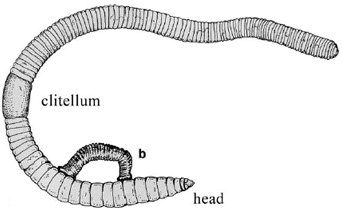- Europe’s only known land leech may be on the brink of extinction due to shifts in climate, report researchers writing in the journal Naturwissenschaften.
- The findings are significant because they suggest that “human-induced climate change without apparent habitat destruction can lead to the extinction of populations of cold-adapted species that have a low colonization ability,” according to the authors.
Europe’s only known land leech may be on the brink of extinction due to shifts in climate, report researchers writing in the journal Naturwissenschaften. The findings are significant because they suggest that “human-induced climate change without apparent habitat destruction can lead to the extinction of populations of cold-adapted species that have a low colonization ability,” according to the authors.
 A land leech in Kalimantan, on the island of Borneo. Photo by Rhett A. Butler |
Land leeches, generally confined to habitats with heavy rainfall in tropical Asia, Australia and Madagascar, are aggressive parasites that commonly feed on the blood of warm-blooded animals, especially mammals. While land leeches are usually found in warm, humid regions, they are also known to occur in temperate climates. The European land leech (Xerobdella lecomtei) is one such species.
Discovered in 1868 in the forests of Austria, Xerobdella lecomtei is believed to be one of the rarest animals on Earth, with only scattered individuals collected over the past 140 years. In an effort to learn more about the elusive species, a team of German and Austrian researchers set out to find individuals living in their natural habitat: birch forests around Graz (Austria). Led by Dr. Ulrich Kutschera, a biology professor at the University of Kassel in Germany, the scientists managed to find only a single specimen in expeditions between 2001 and 2005. Observing the individual — dubbed the “lonesome George of the annelids” — over a four-year period, the researchers learned more the ecology and evolutionary history of this species, which has become “largely extinct over the past four decades.”
Kutschera and colleagues say this decline is due to climate changes in its native habitat, notably a 3-degree Celsius increase in average summer temperature between 1961 and 2004.
 Feeding behavior of a juvenile land leech (Xerobdella lecomtei). The animal to its prey, in this case an earthworm (Lumbricus castaneus) provided by the researchers, and sucks body fluids. In nature the European land leech feeds on amphibians. This drawing, which appeared in the Naturwissenschaften paper, is courtesy of the authors. Kutschera and colleagues say their research shows the importance of proper preservation of museum specimen for ongoing taxonomic research. Without well-preserved specimen, the authors would have had a more difficult time reaching their conclusions on the European land leech. “The DNA-barcoding project… and other initiatives for the documentation and analysis of global biodiversity will depend on collections of ethanol preserved specimens in this era of anthropogenic climate change and habitat destruction,” they write. “We can much better protect organisms that specialists have collected, classified and described in the scientific literature than unknown biodiversity in regions unexplored by ecologists.” |
“The increase in air temperature led to a sharp decline in the moisture content of the soil of the birch forests where the land leeches live, notably in the hot summer of 2003,” write the authors. “Reisinger [the discoverer of the leech] reported that in the laboratory, the optimal temperature for the cultivation and maintenance of Xerobdella populations is around 12°C and that at 25°C these cold-adapted worms rapidly die… Based on our climate data and field observations, we suggest that recent human-induced warming may have led over past decades to the almost complete extinction of a local population of this rare animal species.”
While the researchers allow that populations could still exist in cooler forests, they warn that the decline of the European land leech shows that “human-induced warming without apparent habitat destruction may lead to subtle changes in biodiversity, notably the decline and extinction of populations that consist of cold-adapted species.”
The authors’ conclusion parallels that of a recent paper published in the journal Proceedings of the National Academy of Sciences. That work, led by Steven M. Whitfield of Florida International University, reported a steep decline in amphibian and reptile populations in the rainforests of Costa Rica. Like the demise of the land leech, herp populations fell in otherwise undisturbed habitat: the protected old-growth lowland rainforest of La Selva Biological Station. It seems that a reduced number of rainless days, combined with rising temperatures, has triggered changes in the amount of standing leaf litter, a critical microhabitat for the reptiles and amphibians.
Similar findings were reported earlier this month in the journal Biology letters. Justin Gerlach, an Oxford University biologist with the Nature Protection Trust of Seychelles, found that recent decreases in rainfall likely caused the extinction of the Aldabra banded snail, a rare and beautiful snail, since 1997.
These results, from three very different ecosystems, suggest the outlook is not good for Earth’s most sensitive species. Many scientists believe that the quiet exit of these species is a harbinger of more serious changes to come.
CITATION: U. Kutschera & I. Pfeiffer & E. Ebermann (2007). The European land leech: biology and DNA-based taxonomy of a rare species that is threatened by climate warming. Naturwissenschaften DOI 10.1007/s00114-007-0278-3